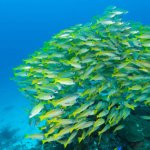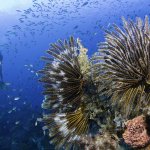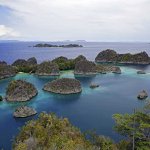Raja Ampat Islands
Overview
The best feature of these islands is their diversity. Over 3000 species of fishes and over 300 species of corals have been identified here. Seas from the Philippines, Maluku Islands, and Australia meet here to support an incredibly prolific and diverse assortment of marine life. In addition to the non-stop fishes, there are oddities like Wobbegongs, giant clams, and a variety of critters.
Strong currents are good for drift diving and isolated lagoons are great for muck diving. Walls, coral slopes, and patch reefs are terrific for all-around diving. Island topography, too, is varied. There are coral cays and granite islands with steep walls. Some areas have hundreds of rock islands similar to those in Palau. Others are surrounded by mangrove forests. This area is not to be missed.
Dive Sites
Cape Kri
Surround yourself in fish at one of Raja Ampat’s fishiest dive destinations. The fish numbers and variety are truly amazing. The site is current dependent with a steep slope featuring beautiful coral growth and lots of reef and schooling fishes, including the giant Queensland grouper, dogtooth tuna, giant trevallies and chevron barracuda.
Sardine Reef
Although you won’t find sardines here, you will find fish as tightly packed. Sardine Reef not only boasts great schools of fish including trevally and tuna but offers up the chance to see giant clams at 10m and strange looking tasselled sharks known as wobbegongs. The resident school of bumphead parrotfish, colourful soft corals and plentiful marine critters make this dive site a must and one that has recorded over 970 species of fish.
The Passage
A drift dive through a narrow but nutrient rich channel near Waigeo. Look for archerfish amongst the mangroves, orange cup corals and percula clownfish, squat lobsters and crinoid shrimps. An abundance of pygmy seahorses steal the show here as they cling to colourful sea fans. Off the wall and in the channel, you’ll also see yellowfin barracuda and mobula and eagle rays passing through.
Kaboei Bay Rock Islands
The bay is a labyrinth of rock islands. Visibility isn’t great but this is a great place for macro and finding odd nudibranches, mollusks and the pictured dragonet. Bat caves and skeletons are found on some of the islands.
Fam Island
Several sites near Fam have stunning coral growth. Sponges and soft corals add color and fishes keep it going. Sites include walls, sloping reefs, and muddy bays.
Misool
Misool is awash in fish life and huge sea fans. Caverns and boulders mark several sites. The schooling fishes seem endless and pygmy seahorses live in less than 10m (33ft). Some sites are current dependent.
Best time to Dive
The best time to dive the Raja Ampats is March to May and August to November, although the season is from March until December. Rainfall is well distributed throughout the year. December to February is generally overcast and July to August is windy. Water temperatures run from 26°-32°C (82-94°F) and are most often 28°-29°C (86-88°F).
Getting there
Raja Ampat is located near the coastal town of Sorong, off the northwest tip of the island New Guinea, Indonesia.
We can arrange a taxi/shuttle/boat transfer to the resort.
Accommodation
Stay on land or at sea. You can choose between a resort or the liveaboard option when visiting Indonesia’s Raja Ampat.
Gallery
We'll find you the best value deals in the most amazing destinations. Let your active travel journey start with us!


